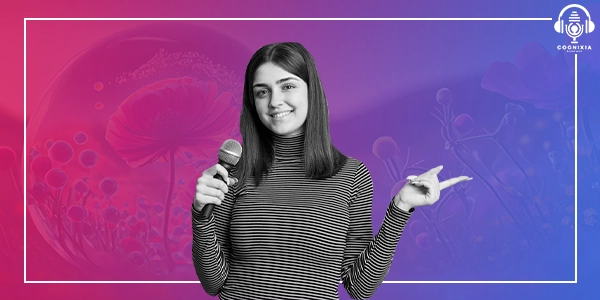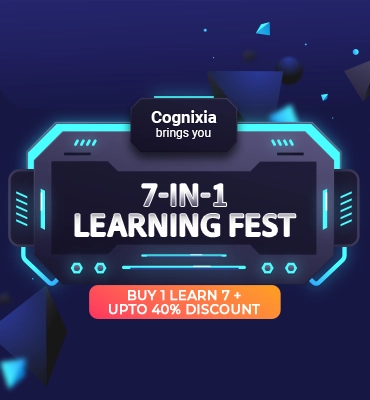Hello everyone and welcome back to the Cognixia podcast! Every week we bring to you some new insights into the world of emerging technologies.
We have an exciting new episode for you today, and we totally cannot keep calm! So grab your popcorn, put on your headphones, and let’s dive right in!
The internet has been absolutely buzzing with a new trend that has taken social media by storm – the Ghibli AI art phenomenon. If you have been anywhere near Instagram, TikTok, or Twitter in the past few weeks, your feeds have likely been flooded with AI-generated images of people transformed into the whimsical, dreamy style of Studio Ghibli characters. This trend has introduced countless individuals who have never experienced the magic of Studio Ghibli movies to the distinctive aesthetic that has captivated audiences worldwide for decades. Today, we are going to unpack this fascinating collision of cutting-edge AI technology and timeless artistic tradition – exploring not just the how but also the why, and perhaps most importantly, the should we?
Let us start with some context on how this all began. OpenAI, the company behind ChatGPT, has been steadily expanding its capabilities beyond just text-based interactions. In early 2023, they introduced DALL-E integration into ChatGPT, allowing users to generate images directly from text prompts within the same interface. This was a significant step forward in making AI image generation more accessible to everyday users.
But the real game-changer came when OpenAI recently launched its enhanced image-generation tool. This upgraded capability allowed users to not only create images from text descriptions but also to apply specific artistic styles to those images. The new tool incorporated more sophisticated style transfer techniques, enabling it to mimic particular artistic aesthetics with remarkable accuracy. Users could now upload their images and have them transformed according to various stylistic parameters.
What makes this tool particularly powerful is its user-friendly interface. Unlike earlier AI image generators that required technical knowledge or complex prompting strategies, ChatGPT’s image tool was designed to be intuitive. You simply describe what you want or upload an image, specify the style you’re looking for, and voilà – the AI delivers results in seconds. This accessibility is precisely what helped the Ghibli trend spread like wildfire across social media platforms.
The tool’s capabilities extend beyond just style transfer. It can generate completely original compositions, modify existing images, combine elements from different sources, and even animate static pictures to a limited degree. These features give users tremendous creative flexibility, allowing them to produce content that would have previously required substantial artistic skill or technical expertise.
So how exactly did the Ghibli trend take off? As with many viral phenomena, it is hard to pinpoint exactly where it began. Sometime in late March 2025, a few social media users discovered that by using specific prompts like “Transform this photo in the style of Studio Ghibli” or “Create a Ghibli-inspired character based on this image,” ChatGPT could produce surprisingly convincing results that captured the essence of Miyazaki’s iconic style.
What started as a trickle quickly turned into a flood. People began sharing their AI-generated Ghibli portraits on platforms like Instagram and TikTok, often side-by-side with their original photos. The contrast between reality and the whimsical Ghibli interpretation created a compelling narrative that encouraged others to try it for themselves. Celebrity influencers got on board, further amplifying the trend’s reach. Before long, everyone from your college roommate to major celebrities was posting their Ghibli avatars online.
The social media mechanics fueled the fire – hashtags like #GhibliMe and #AIGhibli started trending, compilation videos of transformations racked up millions of views on TikTok, Instagram, & X, and tutorial content explaining how to get the best results began to proliferate. It wasn’t just about the images themselves but the shared experience of seeing yourself reimagined in this beloved artistic universe.
What made this trend particularly sticky was its accessibility – anyone with a smartphone could participate. Unlike some viral challenges that require specific skills or props, all you need is a photo of yourself and access to ChatGPT. This low barrier to entry meant that participation could spread exponentially across demographic boundaries.
To understand why this trend resonated so deeply with people, we need to appreciate what makes Studio Ghibli’s aesthetic so special in the first place. Founded in 1985 by directors Hayao Miyazaki, Isao Takahata, and producer Toshio Suzuki, Studio Ghibli has created some of the most beloved animated films of all time – masterpieces like “My Neighbor Totoro,” “Spirited Away,” “Kiki’s Delivery Service,” “Howl’s Moving Castle,” and most recently, “The Boy and the Heron.”
What sets Ghibli films apart is not just their enchanting storytelling but their distinctive visual style. Each frame is a work of art, hand-painted with extraordinary attention to detail. Even in today’s digital age, Studio Ghibli maintains its commitment to traditional animation techniques. The studio’s artists meticulously craft each scene, bringing to life lush natural landscapes, fantastical creatures, and uniquely expressive characters.
The Ghibli aesthetic is instantly recognizable: soft, rounded character designs with large, expressive eyes; dreamlike natural settings with particular attention to the movement of wind, water, and light; a color palette that balances vibrant hues with gentle pastels; and an uncanny ability to make the ordinary seem magical and the magical seem ordinary. These films aren’t just entertaining – they are transportive, creating worlds that feel simultaneously fantastical and deeply familiar.
What many people don’t realize is the sheer labor that goes into creating this distinctive look. A typical Ghibli film contains between 100,000 to 170,000 individual drawings. For comparison, many modern animated films use roughly half that number, relying on computer assistance to fill in the gaps. Studio Ghibli’s commitment to hand-drawn animation means that each frame represents hours of skilled human craftsmanship.
Miyazaki himself is known for his hands-on approach, personally reviewing thousands of drawings for each film and often redrawing key scenes himself. He has famously said, “We take animation – one frame at a time, and concentrate all our efforts on making each frame perfect.” This philosophy of patient, dedicated artistry stands in stark contrast to the instant gratification of AI-generated imagery.
And herein lies the central irony of the Ghibli AI trend – it fundamentally contradicts the artistic philosophy that Miyazaki himself has espoused throughout his career. Hayao Miyazaki is well-known for his skepticism, even outright hostility, toward computer-generated animation and artificial intelligence. In a viral clip from the documentary “The Kingdom of Dreams and Madness,” Miyazaki is shown reacting to an AI animation demonstration with undisguised disgust, calling it “an insult to life itself.”
For Miyazaki, the human element in art is non-negotiable. He believes that true artistic expression must contain the imperfections, inconsistencies, and unique perspectives that come from human hands and minds. The patient labor of animation is not just a means to an end but part of the artistic process itself – a meditation on life and nature that infuses the final work with soul and meaning.
Miyazaki has consistently pushed back against the mechanization of animation, arguing that technological shortcuts lead to spiritual emptiness in the resulting work. He once stated, “Hand-drawn animation is the fundamental basis of our work. And that is something we are going to stick to.” This commitment to traditional techniques isn’t mere nostalgia – it is a philosophical stance about what gives art its power and authenticity.
The AI Ghibli trend, then, represents a fundamental misunderstanding of what makes Ghibli films special. By reducing the studio’s distinctive aesthetic to a style filter that can be applied with a few clicks, it strips away the human intention, skill, and labor that give that aesthetic its depth and resonance. It’s the difference between a mass-produced souvenir and a handcrafted gift – they might look similar at a glance, but one carries human significance that the other cannot.
Furthermore, the trend misses the point that in Ghibli films, style serves story – the visual aesthetic is inseparable from the narratives being told and the themes being explored. Removing that context leaves only a hollow simulacrum, a surface-level approximation that might capture the look but misses the heart.
So how exactly does ChatGPT create these Ghibli-style images? The technology behind this capability is a sophisticated combination of diffusion models and neural networks that have been trained on massive datasets of images. When a user requests a Ghibli-style transformation, the AI processes the input through multiple stages.
First, it analyzes the original image, identifying key elements like faces, objects, and the overall composition. Next, it applies what it has learned about the Ghibli aesthetic from its training data – which includes thousands of frames from Studio Ghibli films – to reinterpret those elements. The system has essentially been taught to recognize patterns in Ghibli’s visual language: the characteristic proportions of faces, the texture of hair, the way light and shadow are represented, the color harmonies typically employed, and other distinctive elements.
The AI doesn’t simply overlay a filter on the original image but actually generates a new image from scratch that maintains certain key characteristics of the input while reimagining it according to the target style. This process involves complex mathematical transformations that occur across multiple layers of the neural network.
What is particularly interesting is that the AI has no actual understanding of what makes Ghibli films visually distinct in a cultural or artistic sense. It has simply identified statistical patterns in the training data and learned to reproduce them. This is why AI-generated Ghibli images often capture the surface-level characteristics but miss subtle nuances that human artists would intuitively understand.
The Ghibli trend hasn’t just been a cultural phenomenon – it has had significant business implications as well. Reports indicate that ChatGPT experienced a substantial spike in downloads and user engagement coinciding with the trend’s peak popularity. OpenAI’s premium subscription service, which offers faster image generation and higher resolution outputs, saw particularly strong growth.
This pattern follows a familiar cycle we have seen with AI tools: a viral use case emerges, driving massive new user acquisition, which then exposes those users to the broader capabilities of the platform. Many people who initially downloaded ChatGPT just to create Ghibli-style images found themselves exploring its other features and becoming regular users.
For OpenAI, this represents a successful growth strategy – creating features that have viral potential and can drive organic user acquisition through social sharing. The company has been steadily expanding its multimedia capabilities, recognizing that visual content tends to spread more rapidly on social platforms than text-based interactions.
The trend also highlights the growing monetization potential of AI-generated content. While basic access to ChatGPT remains free, premium features – including enhanced image generation – require a subscription. This freemium model allows widespread adoption while creating revenue streams from power users and those seeking higher quality outputs.
The Ghibli AI trend raises a host of complex legal and ethical questions that extend far beyond just this specific case. Let’s unpack some of these issues:
First, there’s the matter of copyright law. Studio Ghibli’s visual style is distinctive and recognizable, the product of decades of artistic development. While copyright law typically doesn’t protect style itself, it does protect specific characters and visual elements. The line between inspiration and infringement becomes blurry when AI systems are trained on copyrighted materials without explicit permission and then used to create derivative works that mimic the original too closely.
Licensing considerations also come into play. Studio Ghibli maintains tight control over its intellectual property, carefully managing how its characters and imagery are used in commercial contexts. The company has historically been hesitant to license its properties widely, preferring quality control over ubiquity. The AI trend effectively circumvents these carefully maintained boundaries, creating unauthorized “Ghibli-fied” content at scale.
Then, there is the broader question of data privacy. Every time you upload your photo to an AI tool like ChatGPT, that image becomes data that can and will be stored, analyzed, and used to further train AI models. OpenAI’s privacy policy confirms that unless users explicitly opt out of training data collection or request deletion, their data remains in the company’s possession. This means your personal images could be incorporated into future versions of the AI, potentially being used in ways you never anticipated.
This raises significant personal risks. Facial data is particularly sensitive because it is uniquely tied to your identity and can’t be changed like a password if compromised. Once your facial data enters these systems, controlling its future use becomes virtually impossible. Furthermore, this data could potentially be sold to third parties or accessed by entities beyond the original company, depending on the specific terms of service and privacy policies in place.
The situation becomes even more concerning when we consider that many users don’t fully read or understand these policies before participating in viral trends. The excitement of seeing yourself as a Ghibli character might overshadow the more careful consideration of what you’re agreeing to when you upload your image.

As we navigate this new frontier where AI can instantly generate content mimicking distinctive artistic styles, we need to consider what respecting art and artists really means in the digital age. True appreciation of art goes beyond surface aesthetics – it includes understanding the process, intention, and cultural context behind the work.
Hayao Miyazaki and Studio Ghibli represent a philosophy of patient craftsmanship, of finding meaning in the meticulous process of creation. Their work stands as a testament to what humans can achieve through dedication to their craft. When we reduce this to a one-click filter, we miss the deeper significance of what makes these films special.
This doesn’t mean that AI art tools have no place in our creative ecosystem. Technology has always influenced artistic expression, and AI presents exciting new possibilities for creativity. But there is a difference between using these tools thoughtfully – with an awareness of their limitations and ethical implications – and treating them as shortcuts to artistic authenticity.
The democratization of art doesn’t mean mindless copying or appropriation. True democratization means giving more people the tools, knowledge, and opportunities to develop their own authentic, creative voices. AI can be part of this process, but it should enhance human creativity rather than replace it or trivialize the labor that goes into developing artistic skill.
As we conclude our exploration of the Ghibli AI trend, let us consider what responsible engagement with this technology might look like. Here are a few principles to keep in mind:
First, educate yourself about the art you are mimicking. If the Ghibli trend sparked your interest, take the time to actually watch Studio Ghibli films and learn about their artistic process. Appreciation should go deeper than aesthetic appropriation.
Second, be conscious of privacy implications when using AI tools. Read privacy policies, understand what happens to your data, and make informed choices about what personal information you share.
Third, support original artists directly. If you love Ghibli’s work, purchase official merchandise, attend exhibitions, or subscribe to legitimate streaming services that compensate the studio fairly.
Fourth, use AI tools as a starting point rather than an endpoint. Let them inspire your own creativity rather than replace it. The most interesting AI art emerges when humans and machines collaborate rather than when humans simply consume what machines produce.
Finally, engage critically with these technologies. Question the implications of instant content generation and consider the value we place on human skill, intention, and labor in creative processes.
The Ghibli AI trend represents both the exciting possibilities and complex challenges of our AI-powered future. By approaching these tools thoughtfully and responsibly, we can harness their creative potential while still honoring the human artistry that inspired them in the first place.
And with that, we come to the end of this week’s episode of the Cognixia podcast. We hope you enjoyed listening to us. AI is a powerful tool for any enterprise or individual to leverage, but with great power comes great responsibility. Use AI responsibly, and don’t just mindlessly chase trends.
We will be back again next week with another interesting and exciting new episode of the Cognixia podcast. Until then, happy learning!

